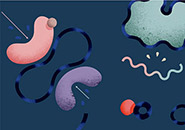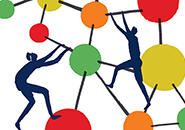If you are a regular reader of the HHMI Bulletin, you may have noticed something different on the cover of this issue. It’s our new logo. We’ve freshened up our identity at HHMI—a move that we feel better reflects the Institute’s spirit of innovation and bold creativity. We acknowledge and celebrate our rich history of achievement, yet we have not been standing still. Indeed, we have been evolving and are a different Institute today than we were just 10 years ago. We strive to continue building our reputation and to better articulate our mission—our new visual identity reflects a greater openness along with our forward momentum.
Over the last decade, we’ve made notable strides to advance science and science education. We’ve launched and developed a new framework of collaborative, interdisciplinary research at the Janelia Research Campus. We’ve broadened our horizons by supporting researchers in new fields, such as plant science, and new countries—from South Africa to South Korea. We’ve launched a scientific journal and new online channels, and created a documentary film production studio to foster science literacy in the classroom and beyond. And we’re partnering with other funders in the scientific, education, and philanthropic communities, collaborating to amplify our collective impact.
Our new visual identity reflects a greater openness along with our forward momentum.
Robert Tjian
As we expand and broaden our activities, I continue to be inspired by the new knowledge that comes out of HHMI researchers’ labs. In the cover story of this issue of the Bulletin, you’ll read about how some of the researchers we support are getting at the root of aneuploidy—the uneven distribution of chromosomes that can occur during errors in cell division. HHMI Investigators Angelika Amon, Hongtao Yu, and others are discovering the molecular details behind how these errors can lead to unexpected consequences, including tumor formation. Understanding the basic mechanisms of cell division—how it works and what happens when the process goes awry—is a necessary step toward effective treatments for cancer and other diseases.
Also in this issue, you’ll learn about our latest class of HHMI professors—top-tier scientists who receive support from HHMI to apply the same creativity in their classrooms as they do in their labs. We are excited to welcome this new group, which is notable for its diversity of ideas for innovating science education. Anne McNeil, a chemist at the University of Michigan, is one of our new HHMI professors. She plans to energize her school’s introductory organic chemistry lab by creating real-world lab projects, such as having students transform used vegetable oil from restaurants into biodiesel fuel for local farmers. At Boston University, bioengineer Muhammad Zaman makes abstract problems concrete for students by asking them to solve global health challenges. Instead of measuring stresses on a beam, for example, students might calculate the stress on a pair of crutches for a disabled child—a real problem in Zambia, where disabilities are common.
These dynamic approaches—in the laboratory and in the classroom—are the hallmark of HHMI, and the essence of what we wanted to capture in our new logo. We hope its fresh, modern look will signal our desire to evolve and build momentum in our continuing commitment to move science forward.













